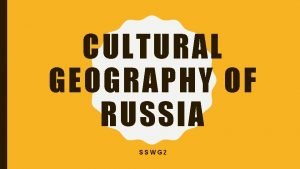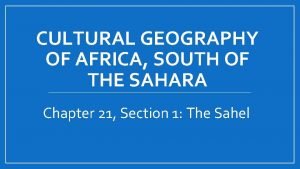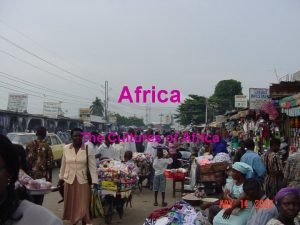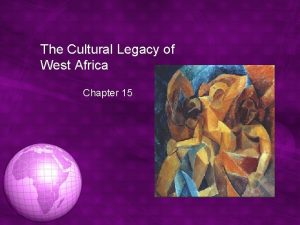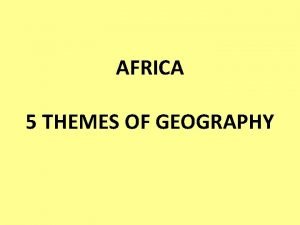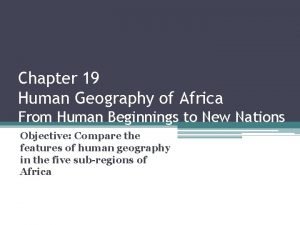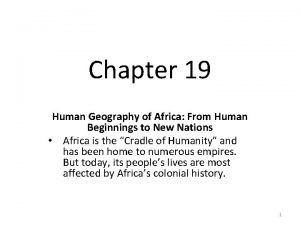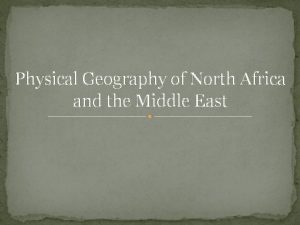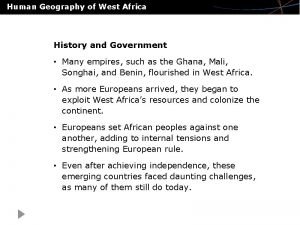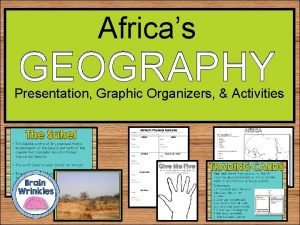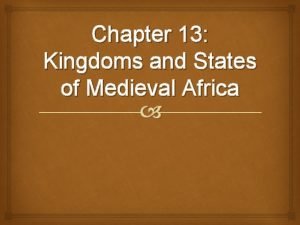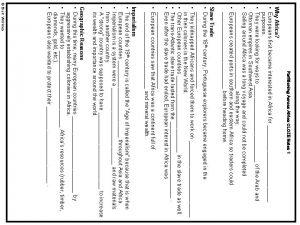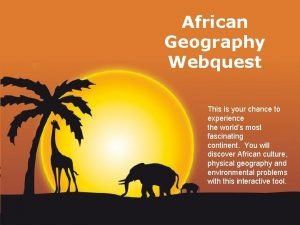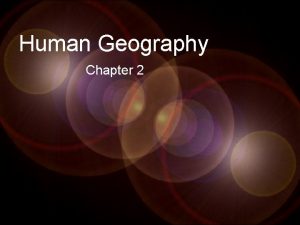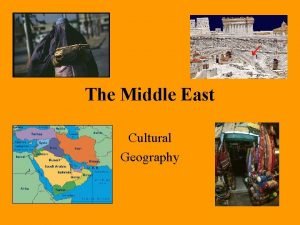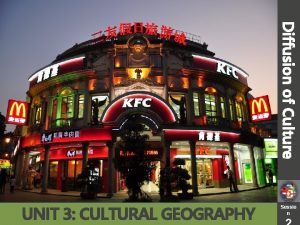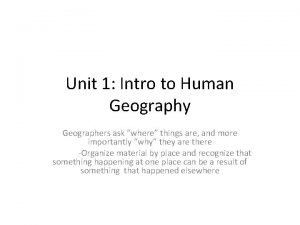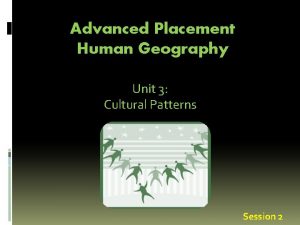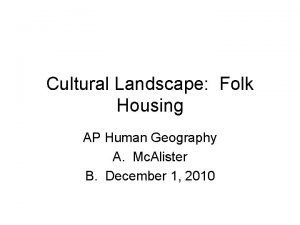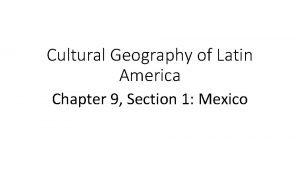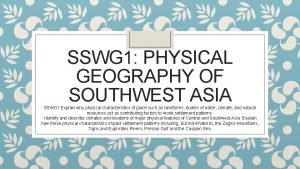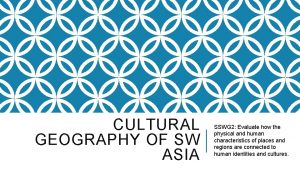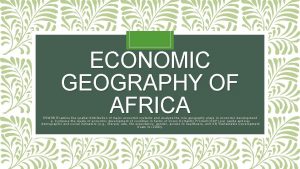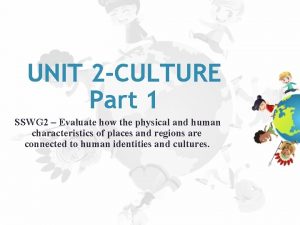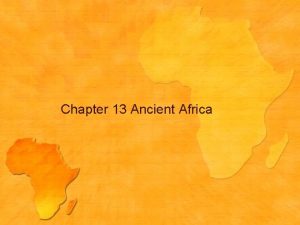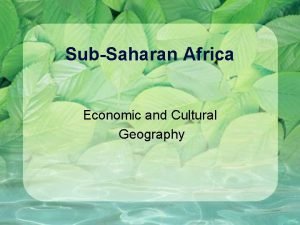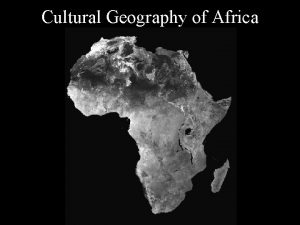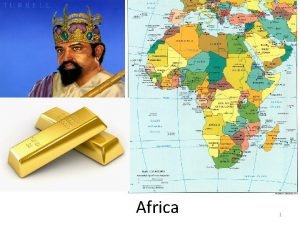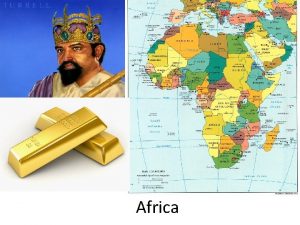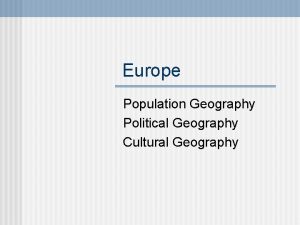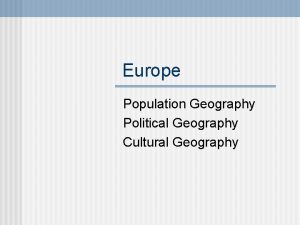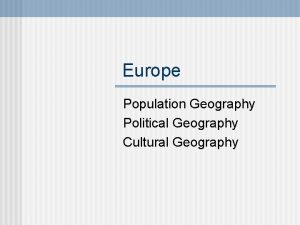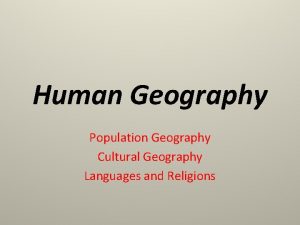CULTURAL GEOGRAPHY OF AFRICA SSWG 2 Evaluate how





























- Slides: 29

CULTURAL GEOGRAPHY OF AFRICA SSWG 2 Evaluate how the physical and human characteristics of places and regions are connected to human identities and cultures a. Examine how ethnic compositions of various groups has led to diversified cultural landscapes, including, but not limited to, architecture, traditions, food, art, and music. b. Examine how language can be central to identity and a unifying or a divisive force (e. g. , Bantu, French-Canadians (Quebecois), and Basques. d. Examine the impact of cultural beliefs on gender roles and perceptions of race and ethnicity as they vary from one region to another (e. g. , the caste system, apartheid, and legal rights for women).


EAST AFRICA

AKSUM • Aksum – important trading center (1000 AD) • Geographic features removed trading partners – deforestation, overuse of soil = population decline = less power • 7 th century – trading center again along African coast • Transfer of goods, ideas, people

BERLIN CONFERENCE • 19 th century – industrialized Europe needs raw materials = colonize and control the resources • Berlin Conference (1884 -1885) = 14 nations meet up to divide Africa • Only Liberia & Ethiopia not under European Control • Divided Africa with no concern for ethnic or language borders • Reason for conflict in Africa

RWANDAN GENOCIDE • Conflict between Hutu & Tutsi • Hutu majority government • Mass killing of Tutsi during Rwandan Civil War • Between 500, 000 & 1, 000 killed • Belgian colonial gov’t put Tutsi in charge & then Hutu took over • Hutu looked at as less than the Tutsi

CULTURES OF EAST AFRICA • Diverse culture because of its position as major trading region • More than 160 different ethnic groups • 2 major ethnic groups – Masai & Kikuyu

Masai Kikuyu • Lives on grasslands of rift valleys in Kenya & Tanzania • Largest ethnic group in Kenya (20%) • Herd livestock & farm land • Today work in variety of jobs • Women = jobs at home • Herders traditionally • Men = herd livestock, protect • Mau – Kikuyu fighters during British colonialism • Clothes from calfskin or buffalo hide • Speak Bantu Kikuyu • Intricate bead work & jewelry • Christianity & traditional religions

NORTH AFRICA

NILE RIVER VALLEY CIVILIZATION • Egypt & Nile River Valley = cultural hearth spread through cultural diffusion • People lived along Nile because of predictable flooding = “gift of the Nile” • Spread ideas through Nile, Mediterranean & Red Seas

ISLAM IN NORTH AFRICA • History of invasion & occupation • Islam remains main cultural & religious influence • Invaders from SW Asia brought language, culture & religion • Spread via conquest & trade

CULTURE OF NORTHERN AFRICA • Combination of Arabic & traditional African ethnic influences • Open air markets where goods are sold • Rai – form of music; symbol of rebellion

WOMEN’S RIGHTS • Women’s roles are changing, although still male-dominated • Spousal abuse, underage marriage & polygamy outlawed • Equal pay, hold professional jobs, members of Parliament

WEST AFRICA

HISTORY OF TRADE • Goree Island - busiest point for exporting slaves during slave trade • Cultural hearth – ideas spread to North America & Europe

M I D D L E P A S S A G E

3 TRADING EMPIRES • Empire of Ghana, Mali & Songhai – thrived because of location on trade routes in Sahara • Promoted trade & agriculture • Many different cultures & peoples • Lived in stateless societies before colonialism • Family lineage to govern themselves

CULTURE OF WEST AFRICA • Ashanti & Benin cultures known for elaborate craftwork & colorful textiles • Art resembles unity of ancestral spirits & living members of family • Benin Bronzes = statues, masks & jewelry • Music – blend of jazz, blues, reggae & traditional African music • Due to American influences from history of slave trade & contact between 2 regions

CENTRAL AFRICA

BANTU MIGRATIONS • Bantu – group of peoples & cultures who speak one of the Bantu languages • 2000 BC – Bantu people moved southward throughout Africa spreading languages & cultures • KEY EVENT IN AFRICA‘S HISTORY • Produce variety of cultures • Link areas of continent • 150 million Africans speak one of the hundreds of Bantu languages

SLAVE TRADE • Slave trade active here as well • Hundreds of different ethnic groups with different religions, languages • Large empires & small villages • King Leopold II of Belgium – wanted control of Central Africa to exploit resources • Belgians & French colonized • Switch to centralized gov’t from traditional forms

RELIGION & COLONIALISM • Christianity Spread through continent through Christian missionaries • Largest religion of Africa

CENTRAL AFRICAN ART • Elements of traditional culture mixed with struggle against colonialism • 1960 s - western influences in art banned • Art focuses on political instability, urban life, social justice & crime • Pablo Picasso (1907) – African Fang sculpture = inspired African elements in his art

SOUTHERN AFRICA

ETHNIC CLASHES • European migrations in 1700 s & 1800 s led to conflict • Many different ethnic groups already in this area – competition between groups & Europeans for land • British defeated Dutch farmers (Boers) and gained control of land – formed South Africa


APARTHEID IN SOUTH AFRICA • 1948 – white minority government instituted policy of apartheid • Complete separation of races • Segregated schools, hospitals, neighborhoods, no social contact • 75% population was black, but got smallest percentage of land • Best land saved for white minority

NELSON MANDELA • • • 1949 – Nelson Mandela leader of African National Congress Went to prison in fight to end apartheid 1989 – new president elected = peaceful revolution = end of apartheid 1944 – Mandela elected president 1996 – passed democratic constitution guaranteeing rights of all citizens

CELEBRATIONS OF SOUTH AFRICA • Blend of cultures & traditions – African & European • Celebrations & festivals – reflect religions beliefs, cure sickness, tell stories, honesty & respect for elders • Johannesburg – modern influences • Apartheid caused wealthy north & poor south to develop • Tradition still remains • Ex. Zulu people
 Cultural geography of russia
Cultural geography of russia Cultural geography of africa
Cultural geography of africa Are west african bantu
Are west african bantu The cultural legacy of west africa answers
The cultural legacy of west africa answers 5 themes of geography africa
5 themes of geography africa Africa geography unit test study guide answer key
Africa geography unit test study guide answer key Chapter 19 human geography of africa
Chapter 19 human geography of africa Africa geography unit test study guide
Africa geography unit test study guide Kums definition geography
Kums definition geography Medieval africa geography
Medieval africa geography Lesson 1 physical geography of southeast asia
Lesson 1 physical geography of southeast asia Poverty during apartheid
Poverty during apartheid Physical features of the middle east map
Physical features of the middle east map Human geography of west africa
Human geography of west africa Africa's geography comprehension check answer key
Africa's geography comprehension check answer key Medieval africa geography
Medieval africa geography European partitioning across africa answer key
European partitioning across africa answer key Label the niger and senegal rivers
Label the niger and senegal rivers Geography webquest
Geography webquest Vocabulary activity 15 cultural geography of russia
Vocabulary activity 15 cultural geography of russia Cultural homogenization ap human geography
Cultural homogenization ap human geography Cultural geography of the middle east
Cultural geography of the middle east Acculturation geography definition
Acculturation geography definition Vocabulary activity 12 cultural geography of europe
Vocabulary activity 12 cultural geography of europe Difference between formal and functional region
Difference between formal and functional region Cultural relativism ap human geography
Cultural relativism ap human geography Fred kniffen housing styles
Fred kniffen housing styles Chapter 9 cultural geography of latin america answers
Chapter 9 cultural geography of latin america answers Whats the definition of cultural diffusion
Whats the definition of cultural diffusion Cultural ecology ap human geography
Cultural ecology ap human geography
